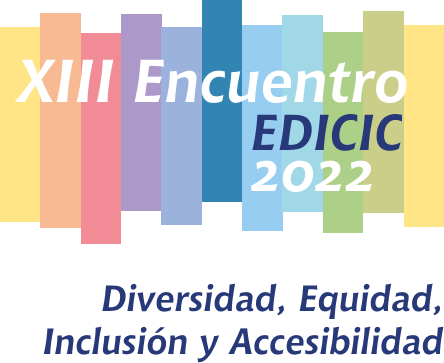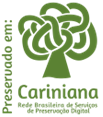“nada sobre nosotros sin nosotros”: tecnología de asistencia y estudios de usuarios de personas con discapacidad visual en bibliotecas universitarias
DOI:
https://doi.org/10.62758/re.v2i4.141Palabras clave:
Estudio de Usuarios, Tecnología de Asistencia, Personas con Discapacidad Visual, Biblioteca Universitaria, AccesibilidadResumen
La creación de legislación internacional para garantizar los derechos de las personas con discapacidad repercutió en el desarrollo de leyes, ordenanzas, decretos y otros instrumentos legales a nivel nacional en varios países. Si bien existe un historial de legislación a favor de las personas con discapacidad, la inclusión social de este grupo se retrasó en varios países, especialmente en el ámbito educativo. El tema de la accesibilidad, en la planificación de las bibliotecas, con énfasis en los estudiantes universitarios, muchas veces no se considera en esta fase inicial, solo se piensa cuando una persona con discapacidad busca atención presencial. En este sentido, se suman las funciones de los recursos de Tecnologías Asistencias como metodologías, instrumentos o equipos para mediar el acceso a la información de los usuarios con discapacidad visual y su contribución a hacer de la biblioteca universitaria un espacio verdaderamente inclusivo. Sin embargo, la existencia de varios factores determinantes, entre ellos la presencia de barreras arquitectónicas, actitudinales e informativas, amplían la distancia entre las bibliotecas y las personas con discapacidad visual o establecen un vínculo superficial, en el que se enfatizan los productos y servicios, mientras que las necesidades de los usuarios muchas veces no se abordan. consultados y raramente abordados. Este estudio tuvo como objetivo identificar, en la literatura de estudios de usuarios, las percepciones de las personas con discapacidad visual sobre los recursos de Tecnología Asistencia presentes en las bibliotecas universitarias. Como marco teórico, aspectos relacionados con el recorrido histórico de los intentos de inclusión de las personas con discapacidad en la sociedad, la importancia de los recursos de Tecnologías Asistencia, con énfasis en las bibliotecas universitarias, para la accesibilidad e inclusión social de las personas con discapacidad en la educación superior y el usuario. estudios como una forma de evaluar la satisfacción de la persona con discapacidad visual en relación con el uso de los recursos de Tecnología Asistencia en las bibliotecas universitarias. Como procedimientos metodológicos, se realizó una revisión bibliográfica en cinco bases de datos: Bases de Datos de Referencia de Artículos en Ciencias de la Información, Scientifc Electronic Library Online, Portal Brasileño de Publicaciones y Datos Científicos en Acceso Abierto, Scopus y Web of Science, en las que se encontraron artículos y artículos de referencia que abordaban el tema investigado fueron seleccionados. Como resultado, se constató que los estudios de usuarios de personas con discapacidad visual en las bibliotecas universitarias aún son escasos y que los recursos de Tecnología Asistencia presentes en estos espacios no siempre contemplan las necesidades de información de este público. Se considera la necesidad de realizar futuros estudios más profundos con las personas con discapacidad visual, reforzando y cumpliendo el lema “Nada de nosotros sin nosotros” y haciéndolos protagonistas para que sean, de hecho, beneficiados e incluidos en la información sociedad.
Citas
Associação Brasileira de Normas Técnicas (2020). NBR 9050/2020: acessibilidade a edificações, mobiliário, espaços e equipamentos urbanos. Associação Brasileira de Normas Técnicas.
Acessibilidade e Inclusão – UFMG. Modelo de deficiência e funcionalidade. (2020, Outubro 22). [Vídeo]. Youtube. https://www.youtube.com/watch?v=ML7C7NJ6MjE&t=1103s.
Amorim, M. L. C. (2006). Construção e adaptação de um teste de atenção para indivíduos com deficiência visual: estudo baseado no Teste de Atenção de Bams. [Dissertação de Mestrado na Universidade do Porto]. Universidade do Porto. https://repositorio- aberto.up.pt/bitstream/10216/14112/2/22593.pdf.
Agabirwe, P. & Kiyingi, G. W. (2020, March 23-26). Utilization of assistive technologies among visually impaired students in university libraries in Uganda: Users’ Experiences. [Conference session]. Sustainable Digital Communities. Boras, Suécia. 470–479. DOI: https://doi.org/10.1007/978-3-030-43687-2_37
Aoyama, P. (2011). Estudo das necessidades de informação dos usuários da Biblioteca Digital do Senado Federal. [Monografia de Graduação em Biblioteconomia]. Faculdade de Ciências da Informação, Universidade de Brasília.
Aranha, M. S. F. (2005). Projeto Escola Viva: garantindo o acesso e permanência de todos os alunos na escola: necessidades educacionais especiais dos alunos. 2 ed. Brasília: Ministério da Educação, Secretaria de Educação Especial.
Araújo, C. A. A. (2010). Abordagem interacionista de estudos de usuários da informação. Ponto de Acesso, 4(2), 2-32. DOI: https://doi.org/10.9771/1981-6766rpa.v4i2.3856
Asebriy Z., Raghay, S. & Bencharef, O. (2018). An assistive technology for braille users to support mathematical learning: a semantic retrieval system. Symmetry, 10(11), 1-16. https://doi.org/10.3390/sym10110547. DOI: https://doi.org/10.3390/sym10110547
Baptista, S. G. & Cunha, M. B. (2007). Estudo de usuários: visão global dos métodos das coletas de dados. Perspectivas em Ciência da Informação, 12(2), 168-184. DOI: https://doi.org/10.1590/S1413-99362007000200011
Bardwaj, R. K. (2018). Information access mechanism for visually impaired students in higher educational institutions: a study. Journal of Library & Information Technology, 38(6), 387-395. DOI: 10.14429/djlit.38.6.13603 DOI: https://doi.org/10.14429/djlit.38.6.13603
Bersch, R. (2008). Introdução às tecnologias assistivas. http://www.assistiva.com.br/Introducao_Tecnologia_Assistiva.pdf.
Chaurasia, A. & Singh, A. P. (2022). Assistive Support through technologies for persons with disabilities in libraries. Journal of Library & Information Technology, 42(2), 130-135. DOI: 10.14429/djlit.42.2.17558. DOI: https://doi.org/10.14429/djlit.42.2.17558
Chen, Q. (2014). Applied-information technology in barrier-free service of university library. Advanced Materials Research, 1021, 257-260. https://doi.org/10.4028/www.scientific.net/AMR.1021.257. DOI: https://doi.org/10.4028/www.scientific.net/AMR.1021.257
Coneglian, A. L. O. & Casarin, H. C. S. (2014). Deficientes como usuários de informação. In: Casarin, H. C. S. (Org.). Estudos de usuário da informação. Marília: Oficina Universitária. (pp. 220-254).
Corrêa, M. A. M. (2005). Educação especial: v.01. Fundação CECIERJ. https://canalcederj.cecierj.edu.br/012016/a1af164aed3aff470abbd469102d4a12.pdf.
Cunha, M. B. (1982). Metodologias para estudos de usuários de informação científica e tecnológica. Revista de Biblioteconomia de Brasília, 10(2), 5-20.
Cunha, M. B.; Amaral, S. A.; Dantas, E. B. (2015). Manual de estudo de usuários da informação. Atlas.
Dias, M. M. K. & Pires, D. (2004). Usos e usuários da informação. São Carlos: Edufscar.
Dodamani, A. M. & Dodamani, S. M. (2019). Provision of assistive technology for students with visual impairment in university libraries in India. Journal of Library & Information Technology, 39(3), 104-108. DOI: 10.14429/djlit.39.3.14329. DOI: https://doi.org/10.14429/djlit.39.3.14329
Ferreira, K. L. C., Dias, A. C. B., Freitas, M. K. S., Farias, K. A. & Brasil, E. C. A. (2019, Outubro 1-4). Análise de medidas acessíveis na Biblioteca Universitária da UFC Campus Quixadá. Congresso Brasileiro de Biblioteconomia e Documentação, Vitória, ES, Brasil. https://repositorio.ufc.br/bitstream/riufc/49136/1/2019_resumo_klcferreira.pdf.
Figueiredo, N. M. (1983). Aspectos especiais de estudos de usuários. Ci. Inf., 12(2), 43-57.
Fundação Dorina Nowill (2022). https://fundacaodorina.org.br/a-fundacao/pessoas-cegas-e-com-baixa-visao/estatisticas-da-deficiencia-visual/.
Gil, M. (Org.) (2000). Deficiência visual. Secretaria de Educação a Distância. http://portal.mec.gov.br/seed/arquivos/pdf/deficienciavisual.pdf.
Instituto Brasileiro de Geografia e Estatística (2010). Censo 2010. https://www.ibge.gov.b/estatisticas-novoportal/sociais/educacao/9662-censo-demografico- 2010.html?edicao=9749&t=destaques.
Kumar, S.; Sanaman, G. (2013). Web challenges faced by blind and vision impaired users in libraries of Delhi. The Electronic Library, 33(2), 242-257. DOI: https://doi.org/10.1108/EL-03-2013-0043
Masini, E. F. S. (1994). O perceber e o relacionar-se do deficiente visual: orientando professores especializados. Coordenação Nacional de Integração de Pessoa Portadora de Deficiência.
Melo, A. M., Costa, J. B. & Soares, S. C. M. (2006) Tecnologias assistivas. In: Pupo, D. T., Melo, A. M. & Ferrés, S. P. (Orgs.). Acessibilidade: discurso e prática no cotidiano das bibliotecas . Campinas: Unicamp. (pp. 62-70).
Merizio, T. M. P. (1999). Necessidades informacionais dos deficientes visuais do CEAD. [Trabalho de Conclusão de Curso de Graduação em Biblioteconomia]. Universidade Estadual de Londrina.
Mutula S. & Majinge R. M. (2016). Information behavior of students living with visual impairments in university libraries: a review of related literature. The Journal of Academic Librarianship, 42(2016), 522-528. http://dx.doi.org/10.1016/j.acalib.2016.06.019 0. DOI: https://doi.org/10.1016/j.acalib.2016.06.019
Oliveira, M. (Coord.) (2011). Ciência da Informação e Biblioteconomia: novos conteúdos e espaços de atuação. (2.ed.) Belo Horizonte: UFMG.
Organização Mundial de Saúde (2011). https://nacoesunidas.org/acao/pessoas-com-deficiencia/.
Pelosi, M. B. (2006). Por uma escola que ensine e não apenas acolha recursos e estratégias para a inclusão escolar. In: Manzini, E. J. Inclusão e acessibilidade. ABPEE. (pp. 121- 132).
Pinheiro, A. C. (2021). Os recursos de Tecnologia Assistiva nas bibliotecas universitárias federais brasileiras: uma abordagem para as pessoas com deficiências visuais. [Dissertação de mestrado em Ciência da Informação]. Universidade Federal de Minas Gerais.
Rodrigues, P. R. & Alves, L. R. (2013).Tecnologia assistiva: uma revisão do tema. Holos, (6)29, 170-180. https://doi.org/10.15628/holos.2013.1595. DOI: https://doi.org/10.15628/holos.2013.1595
Santos, K. G. & Carvalho, K. A. (2019). Acessibilidade e tecnologia assistiva em bibliotecas universitárias: estudo de caso no Centro Federal de Educação Tecnológica de Minas Gerais. Revista Ibero-Americana de Ciência da Informação, 13(1), 5-19. https://doi.org/10.26512/rici.v13.n1.2020.22362. DOI: https://doi.org/10.26512/rici.v13.n1.2020.22362
Sassaki, R. K. (2006). Inclusão: construindo uma sociedade para todos. WVA.
Saracevic, T. (1997). Users lost: reflections on the past, future, andlimits of information science. ACM SIGIR Forum, 31(2), 16-27. DOI: https://doi.org/10.1145/270886.270889
Sawyer, S. & Huang, H. (2007). Conceptualizing information, technology, and people: comparing information science and information systems literatures. Journal of the American Society for Information Science and Technology, 58(10), 1436-1447. https://doi.org/10.1002/asi.20621. DOI: https://doi.org/10.1002/asi.20621
Souza, O. & Tabosa, H. R. (2018). Estudo sobre a contribuição da Ciência da Informação em pesquisas sobre Tecnologias Assistivas. Comunicação & Informação, 21(1), 70-88. DOI: https://doi.org/10.5216/ci.v21i1.45987
Universidade Aberta do SUS da Universidade Federal do Maranhão (2019, Outubro 22). Modelo biomédico e biopsicossocial da deficiência. [Vídeo]. Youtube. https://www.youtube.com/watch?v=tPq9FaYxY6k.
Wellichan. D. S. P., Lino, C. C. T. S. & Manzini E. J. (2021). Biblioteca na vida acadêmica de um estudante surdo: um relato de experiência. InCID: R. Ci. Inf. e Doc, 12(2), 284-304. DOI: 10.11606/issn.2178-2075.v12i2p284-304. DOI: https://doi.org/10.11606/issn.2178-2075.v12i2p284-304
Wellichan, D. S. P. & Manzini, E. J. (2018). A Tecnologia Assistiva em bibliotecas públicas: uma abordagem preliminar sobre sua importância e contribuição para usuários com deficiência. Biblionline, 14(4), 83-90. DOI: https://doi.org/10.22478/ufpb.1809-4775.2018v14n4.42021. DOI: https://doi.org/10.22478/ufpb.1809-4775.2018v14n4.42021
Wellichan, D. S. P. & Manzini, E. J. (2021). Usuários da informação com deficiência em bibliotecas: uma análise da produção científica em Biblioteconomia e Ciência da Informação. Em Questão, 27(3), 172-203. DOI: https://doi.org/10.19132/1808-5245273.172-203. DOI: https://doi.org/10.19132/1808-5245273.172-203
Descargas
Publicado
Cómo citar
Número
Sección
Licencia
Derechos de autor 2022 Revista EDICIC

Esta obra está bajo una licencia internacional Creative Commons Atribución 4.0.
La Asociación posee los derechos de autor de los textos que publica y adopta la licencia Creative Commons, CC BY 4.0 DEED Atribución 4.0 Internacional (https://creativecommons.org/
Usted es libre de:
- Compartir: copiar y redistribuir el material en cualquier medio o formato para cualquier propósito, incluso comercialmente.
- Adaptar: remezclar, transformar y construir a partir del material para cualquier propósito, incluso comercialmente.






